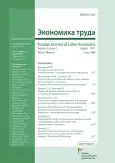Digital capital of the labor force in Russia: regional differentiation
- Authors: Kapelyuk S.D.1,2, Karelin I.N.1
-
Affiliations:
- Novosibirsk State Technical University
- Novosibirsk State University of Economics and Management
- Issue: Vol 10, No 8 (2023)
- Pages: 1169-1184
- Section: Articles
- URL: https://journals.rcsi.science/2410-1613/article/view/146258
- DOI: https://doi.org/10.18334/et.10.8.118335
- ID: 146258
Cite item
Abstract
About the authors
Sergey Dmitrievich Kapelyuk
Novosibirsk State Technical University; Novosibirsk State University of Economics and Management
Email: skapelyuk@bk.ru
Доцент кафедры экономической теории и прикладной экономики, кандидат экономических наук, доцентДоцент кафедры экономики предпринимательской деятельности и логистики
Ilya Nikolaevich Karelin
Novosibirsk State Technical University
Email: karelin@corp.nstu.ru
Старший преподаватель кафедры экономической теории и прикладной экономики
References
- Вартанова Е.Л., Гладкова А.А. Цифровое неравенство, цифровой капитал, цифровая включенность: динамика теоретических подходов и политических решений // Вестник Московского университета. Серия 10. Журналистика. – 2021. – № 1. – c. 3–29. – doi: 10.30547/vestnik.journ.1.2021.329.
- Горяинов А.Н. Коллекция кейсов и инструментов для оценки цифровых компетенций в рамках программы DigComp // Цифровая трансформация образования: сб. мат. 2-й Межд. науч.-практ. конф., Минск, 27 марта 2019 г. – Минск: ГИАЦ Минобразования. Минск, 2019. – c. 329–331.
- Ивашиненко Н.Н., Варызгина А.А., Михайлова В.В. Формирование цифрового капитала у населения России // Гуманитарные, социально-экономические и общественные науки. – 2022. – № 5. – c. 50–54. – doi: 10.23672/Y6341-3933-5752-C.
- Индикаторы цифровой экономики: 2022. / под ред. Н. Анисимов [и др.]. - М.: Национальный исследовательский университет «Высшая школа экономики», 2023. – 332 c.
- Капелюк С.Д., Карелин И.Н. Спрос на цифровые навыки в России: региональные различия // Пространственная экономика. – 2023. – № 1. – c. 70–92. – doi: 10.14530.
- Капелюк С.Д., Карелин И.Н. Динамика востребованности цифровых навыков на рынке труда регионов России // Π-Economy. – 2023. – № 1 (16). – c. 51–61. – doi: 10.18721/JE.16104.
- Карапетян Р.В., Сизова И.Л., Бакаев М.А. Текущие и ожидаемые параметры прироста цифровых компетенций у занятого населения (пример Санкт-Петербурга) // Вестник Института социологии. – 2020. – № 1. – c. 113–136. – doi: 10.19181/vis.2020.11.1.629.
- Лищук Е.Н., Капелюк С.Д. Легко ли стать безработным? // Экономика труда. – 2022. – № 8. – c. 1263-1280. – doi: 10.18334/et.9.8.114905.
- Beblavý M., Fabo B., Lenaerts K. Demand for digital skills in the US labour market: the IT skills pyramid. / CEPS Special Report No. 154/December 2016., 2016.
- Deming D.J., Noray K. Earnings dynamics, changing job skills, and STEM careers // The Quarterly Journal of Economics. – 2020. – № 4 (135). – p. 1965–2005. – doi: 10.1093/qje/qjaa021.
- Deming D., Kahn L.B. Skill requirements across firms and labor markets: Evidence from job postings for professionals // Journal of Labor Economics. – 2018. – p. S337–S369. – doi: 10.1086/694106.
- Gladkova A., Vartanova E., Ragnedda M. Digital divide and digital capital in multiethnic Russian society // Journal of Multicultural Discourses. – 2020. – № 2. – p. 126–147. – doi: 10.1080/17447143.2020.1745212.
- Park S. Digital capital. - London: Palgrave Macmillan, 2017. – 247 p.
- Ragnedda M. Conceptualizing Digital Capital // Telematics and Informatics. – 2018. – № 8. – p. 2366–2375. – doi: 10.1016/j.tele.2018.10.006.
- Ragnedda M., Ruiu M.L., Addeo F. Measuring digital capital: An empirical investigation // New Media Society. – 2020. – № 5 (22). – p. 793–816. – doi: 10.1177/1461444819869604.
- Tambe P., Hitt L., Rock D., Brynjolfsson E. Digital capital and superstar firms. - Cambridge, MA: National Bureau of Economic Research, 2020.
- Vuorikari R., Kluzer S., Punie Y. DigComp 2.2: The Digital Competence Framework for Citizens-With new examples of knowledge, skills and attitudes. - Joint Research Centre (Seville site), 2022.
- ESCO v1.1.0. European Commission, 2022. [Электронный ресурс]. URL: https://esco.ec.europa.eu/en/classification/skill_main (дата обращения: 24.02.2023).
Supplementary files








